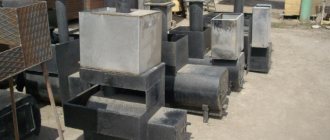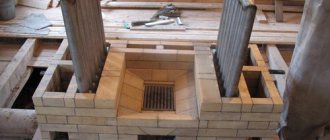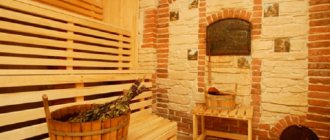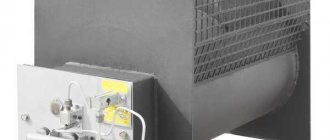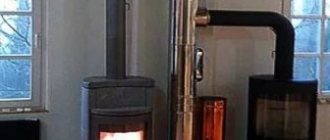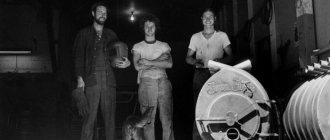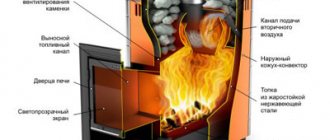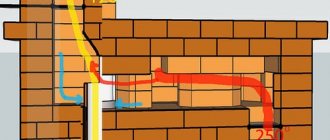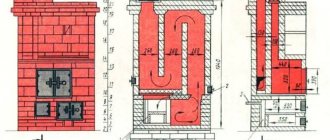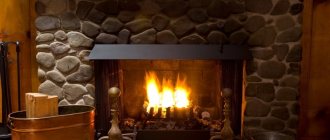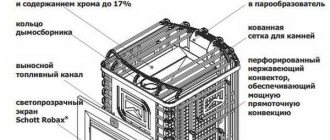When planning a site for a country house, most owners strive to allocate a site for building a bathhouse. This place will not only help keep the body clean, but will also give health to the body for a long time and increase vitality. For Russian people, the bathhouse has always been more than just a place for taking water procedures. This is a whole cult that traditionally receives a lot of attention.
The central place inside is occupied by wood-burning sauna boilers with a tank. This type of fuel has a significant number of advantages over others. Also, during construction, it is possible to choose the most comfortable design scheme and its individual elements for a specific room. If you can’t do everything yourself, then you can simply buy a boiler for a wood-burning sauna, but this will require a much larger financial investment.
What does the boiler consist of?
Before choosing a ready-made boiler for a wood-burning sauna or its design for construction, you need to familiarize yourself with the internal structure of the system and its components. The overall efficiency of the design depends on the coordinated work of each component with the others.
The following elements are necessarily present in the scheme of homemade boilers for a wood-burning bath:
- The base part is a heater. It promotes the accumulation of heat generated by the system. The duration of retention depends on the total volume of the stone fill capable of retaining the thermal energy generated by the firewood.
- Central chimney. Its basis is a vertical pipe through which light combustion products are discharged. It also generates traction, ensuring the circulation of air currents.
- Boilers for wood-fired saunas in Voronezh, Orel, Samara or another city cannot do without a water heat exchanger. Its function is to heat water for later use.
- A passage tunnel with a small door will allow you to heat wood-fired sauna boilers, the price of which depends on the design, from the dressing room or from an adjacent room. This door is often made of heat-resistant glass.
- Firebox (firebox), the area in which firewood or other available solid fuel is heated. In this zone, heat is released from combustion products. The lower part is equipped with a grate of grates on which fuel is placed for various types, including cast iron boilers for wood-fired saunas. You will need to mount the door opposite the firebox, and also form bevels to automatically roll off combustion residues.
- In the lower part, the boilers of wood-burning baths (photos are presented on the page) have an ash pit. They are located under the grate and serve to collect burnt ash falling from the firebox.
Each do-it-yourself water boiler for a wood-fired sauna may differ from its analogues in the structural arrangement of individual elements. At the same time, dimensional parameters affect its performance.
Operating principle and device
Modern boilers for wood-fired baths, made with your own hands or purchased in a specialized store, have the same operating principle as those built many years ago. Solid fuel is placed inside the firebox in one of the possible ways. The option depends on the type of oven. During combustion, ash and soot accumulate. They wake up through the grate into the ash pit. From there, the cooled particles are removed manually with a spatula.
Warm air, heated by burning wood from the firebox, rises, providing heat to the heater and the layer of stones located on it. The latter slowly gives off its heat to the room, providing a comfortable temperature for the steam room.
Manufacturers offer combination boilers for wood-fired saunas that use gas as an alternative heating method. However, not all areas have the opportunity to connect to the gas supply system, so the classic monofuel model is more popular.
The difference between the designs of boilers in a wood-burning bathhouse (photo below, price here or on the manufacturer’s website) most often lies in the location of the water tank.
There are several areas of its installation that have positive qualities:
- Schemes with remote tanks. This type is the most popular design. With its help, it is possible to obtain hot water used in heating the remaining rooms of the building. This model allows you to warm up the air inside well before the water has time to boil. It is in demand in baths that use dry and hot air. High-quality stainless steel is used for the tank material. Installation is carried out, as a rule, in an adjacent room, and the connection is made using registers or a pipe hose. The disadvantage of the design is the relative complexity of installation work, additional costs for registers and labor-intensive installation.
- The mounting tank is mounted directly into the chamber to the firebox. The design is relevant for stoves made of pipes. The water in them is heated at the top point of the firebox. However, this is not always an effective solution. The main rule used when installing such structures is maximum tightness for all seams, which will extend the service life of the device.
- The installation of a tank on a chimney pipe differs in two installation options: a tank in the shape of a cube or parallelogram serves as a passage unit to the roof, or the tank serves as a passage unit through the ceiling to the second floor. The container is heated not only due to heat exchange in the pipe, but also thanks to the furnace registers, which allows the use of significant volumes during heating of the liquid.
- The tank's hinged design allows for mounting on a wall or other vertical surface. The water is heated inside due to the heat exchange received from the furnace walls. The material used for this design is stainless steel.
Average prices for stoves with different locations of the water tank
| Name (brand) | Type of water tank location | price, rub. |
| Tungussk | on the chimney | from 12000 |
| Helo (Finland) | built-in | from 27000 |
| Sahara | mounted | from 14000 |
Design and types of boilers for steam rooms
The main task of the heat source in the bathhouse is to effectively burn solid fuel and thereby heat the air in the room to 100 ⁰C, and in some cases even more. Therefore, the design of a boiler for a bath should provide for intense heat exchange between heated surfaces and air. For this reason, steam room boilers do not have a water jacket; they can only be equipped with a separate tank for heating water. In heating the room there is a radiant component from the heated outer walls of the firebox. The second component of the heat flow, convective, is present due to the ribs made outside the furnace body. They are washed by the room air, which circulates from the bottom up due to heating.
Wood-burning sauna boiler
To install the heater, the installation provides a special container, which, as a rule, is fixed on top of the body. Some wood-burning stoves and sauna boilers are equipped with a mesh that encloses the firebox on all sides and serves to fill the stones.
Heating boiler for a bath
The third, and most expensive option for a heating installation is a stove finished with polished natural stone.
An electric heating boiler for a bath is an option for homeowners who have the necessary electricity limits and who prioritize operating comfort above all else. Installations of this type are fully automated, do not require kindling and can be used even in city apartments with appropriate exhaust ventilation. But every lover of a traditional Russian bath will say that the heat from them is “lifeless” and using such a steam room does not bring much pleasure. In fact, the hot surfaces of heating elements deprive the air of natural ionization, giving it a certain “artificiality”, hence the health benefits of such a steam room are low.
Stone finishing
The best effect in all respects will be achieved by installing a boiler in a bathhouse made of special brick or natural stone. They are durable, give off excellent heat and retain heat for a long time after extinguishing. Stone boilers have an excellent aesthetic appearance and fit well into the interior of the room. There are ready-made sets of such baths on sale, but the cost of materials and installation is very high; for these reasons, stone stoves are not available to everyone.
Designs with built-in or mounted water tank
A water heating tank is a metal container of a certain volume into which cold water is initially poured and during the heating process of the furnace it is heated.
A hanging tank, which is located on the other side of the stove (in some cases even in another room) is not always convenient. Also dubious is the pleasure of washing from the tank, which is built into the stove body.
Firstly, it is impossible to control how much water is left and whether it needs to be added. Secondly, constantly boiling water produces too much steam, which is not very comfortable for a small steam room.
Advantages of a remote water tank
Any storage container in a bathhouse can be heated in one of two ways - either from the firebox itself or from the chimney pipe. The remote tank can only heat up through the pipes leading from the furnace coil. The disadvantage of the design is the need to be close to the stove (no more than 300 cm), but for most steam rooms this is enough.
Example of a remote water tank
In general, heating water in a bathhouse can be organized systematically - if the tank is large, the best location would be a chimney, when the passing hot smoke heats the water. Small storage tanks can be installed directly on the heater, but then it is necessary to organize a good steam outlet. It is advisable to install small tanks outside the steam room.
Review of the best models
The market offers wood-burning sauna stoves with tanks from both domestic and foreign manufacturers. Let's review the best models that have earned customer recognition.
| Category | Name | price, rub. |
| The best foreign boilers for wood-fired saunas with a tank | Harvia 20 ES Pro S | 39000 |
| HARVIA 36 DUO | 89000 | |
| Kastor Karhu 18 PK ES | 49000 | |
| The best Russian boilers for wood-fired saunas with a tank | Taman 10 TB | 12000 |
| Ermak 12 | 11900 | |
| Varvara Polenitsa | 18000 | |
| Volcano Elbrus 26 Standard | 24000 |
Recommendations for choosing a boiler for a steam room
If you have chosen a traditional type of fuel for yourself - wood, then the choice of a boiler for a bath in your case will be made between two options: a steel or cast iron body of the unit. Cast iron is a fragile material, so when choosing a boiler made of this material, you need to make sure that there are no thin parts in the design. During long-term use, thin cast iron elements can simply break. It is necessary to ensure that the wood-burning boiler for a Russian bath made of cast iron has massive door hinges, handles for opening them and other parts. It is worth inspecting the working surface of the combustion chamber and the rest of the body casting for manufacturing defects in the form of cracks or chips.
Cast iron boiler for a bath
Wood-burning stoves for steam rooms are presented on the market by several domestic and foreign manufacturers. Among them, the presence of Finnish brands such as NARVI or KASTOR is natural. As a rule, Finnish sauna boilers are made with high quality and do not cause any complaints during operation. The only requirement that must be met, regardless of the type of unit purchased, is to ensure good draft of the chimney pipe. Without this, the furnace will never reach its designed capacity and will not be able to heat your room to a high temperature. If the draft is too high, the problem can be solved by closing the damper, but the lack of draft is much more difficult to correct.
When choosing a boiler, you should pay attention to the chimney duct inside the unit. It is desirable that it has as few bends and turns as possible on its way out. This is especially true for steel units, since the temperature of the flue gases in them is high and in places of greatest resistance the metal will burn more intensely.
The best foreign boilers for wood-fired saunas with a tank
When choosing a boiler for a wood-fired sauna, you should also think about its safety. Domestic models are often energy independent; foreign products require an electrical connection
Harvia 20 ES Pro S
A budget option from a Finnish manufacturer, which is characterized by a long service life, high performance and convenient operation.
Harvia 20 ES Pro S
Model specifications:
- Dimensions – 430x760x650 mm
- Weight – 75 kg
- Thermal power – 18 kW
- Chimney diameter – 115 mm
- The volume of the built-in tank is 20 liters.
The outer casing of the unit is made of stainless steel, there is a cast iron door with glass to complement the special atmosphere of the sauna with the reflections of the fire.
The average cost of the stove will be 39,000 rubles.
Operating instructions Harvia 20 ES Pro S
HARVIA 36 DUO
The peculiarity of this model is that the body is made of stainless steel, resistant to corrosion, which is especially important when using the device in a sauna or bathhouse. The stove is installed in the steam room, but the fire is carried out from the adjacent room.
HARVIA 36 DUO
Specifications:
- Dimensions – 810x510x510 mm
- Weight without stones – 80 kg
- Thermal power – 31 kW
- Steam room volume – 14-36 cubic meters
- Chimney diameter – 115 mm
The average cost is 89,000 rubles.
Operating instructions HARVIA 36 DUO
Kastor Karhu 18 PK ES
A model with a built-in tank from a well-known Finnish manufacturer, which has been supplying high-quality stoves for baths and saunas to European markets for almost 100 years. Kastor Karhu 18 PK ES is made of stainless alloy metal and has a heat-resistant glass insert in the door.
Kastor Karhu 18 PK ES
Product Specifications:
- Dimensions – 435x695x780mm.
- Tank volume – 26 liters.
- Chimney diameter – 135 mm.
- The weight of the stove is 76 kg.
- The volume of the steam room is up to 18 cubic meters. meters.
The average cost of this model will be 49,000 rubles.
Operating instructions Kastor Karhu 18 PK ES
The best Russian boilers for wood-fired saunas with a tank
Russian models of wood-burning boilers are recognized throughout the world as high-quality and reliable equipment without any frills and excessive automation of combustion processes.
Taman 10 TB
One of the best domestic models, which, when designing the product, paid great attention to the issue of the temperature of the exhaust flue gases, reducing it to a minimum and thereby ensuring a comfortable atmosphere in the steam room.
Taman 10 TB
Specifications:
- Dimensions – 702x331x850mm.
- Weight – 46 kg.
- Material – structural steel.
- Type of heater: open.
- Chimney diameter – 115 mm.
- The volume of the steam room is up to 10 cubic meters.
The main advantage of the model is that the firebox walls are made of structural steel up to 4 mm thick, which ensures a long service life of the product. It is also worth noting the low cost of the device - on average, the purchase will cost 12,000 rubles.
Operating instructions Taman 10 TB
Ermak 12
Compact model for arranging a small bathhouse with a steam room volume of up to 14 square meters. meters. The firebox is made of steel 6 mm thick. The body and flue system are made of steel 4 mm thick, in places with the greatest thermal load - lined steel up to 6 mm.
Ermak 12
Design Features:
- Firebox depth – up to 500 mm.
- The location of the chimney is central.
- Power – 12 kW.
The average cost of such a stove is 11,900 rubles.
Operating instructions for Ermak 12
Varvara Polenitsa
A stove for a bath from a Tver manufacturer, which offers its customers economical and easy-to-use designs. A convenient option for a bathhouse that is not connected to a water supply. The water tank is hung in a special pocket on the side wall of the stove; heating is carried out by heat transfer from the wall of the structure. The main advantage is that the tank is removable, it is easy to remove and wash.
Varvara Polenitsa
Technical characteristics of the device:
- Power – 18 kW.
- Combustion chamber capacity – 0.075 cubic meters.
- Fuel - firewood.
- Dimensions – 860x450x720 mm.
- Weight – 120 kg.
- The internal volume of the chimney is 110mm.
- The volume of the steam room is 24 cubic meters. meters.
- The capacity of the mounted tank is 50 liters.
Among the advantages of this model, it is worth highlighting such points as ease of installation and maintenance, there is no need for a water supply system, the water tank is made of food-grade steel, fast heating of water, uniform heating of the stones.
And, of course, we should not forget about this main advantage - it is affordable - the average price of the product will be 18,000 rubles.
How to make a boiler for a bathhouse
Assembling a bath boiler with your own hands will not be difficult if you know how to use a grinder and a welding machine. The structure is welded according to a finished drawing or your own design is developed. It is only important to know what components a heating device for a bath consists of.
Construction of homemade boilers
Homemade products differ in shape, which depends on the material of manufacture (pipe or sheet steel). The design of a heating device for a bath consists of the following components:
Now it’s worth considering the nuances of the design. The boiler is made slightly elongated so that the doors of the firebox and ash pan open into the dressing room. The building itself enters the steam room through the wall. The heater is not a mandatory unit. The steam room can be heated from the body and boiling water in the tank.
When making a boiler, it is not advisable to save on the heater.
If the bathhouse is large and there are many rooms, a full heating system will be required. The heating device is equipped with another unit - a heat exchanger. The tank or coil is located in the firebox. A pipeline with radiators is connected to the heat exchanger. The system is filled with coolant, most often water or antifreeze.
Cylindrical boiler
A cylindrical boiler is easier to manufacture due to fewer welded joints. The material will be a barrel or pipe with a diameter of at least 50 cm. It is advisable to select thick metal - about 6 mm. The service life depends on this.
To make a cylindrical model, cut a piece of pipe 1 m long. The ends are sealed with a plug. Where the bottom will be, 4 small legs are welded. At a height of 5 cm from the bottom, a rectangular ash pan window is cut in the pipe with a grinder. A door is made from a cut out piece of metal and attached to the pipe with hinges near the vent.
Grate bars are welded inside the pipe 10 cm above the ash pan. They can be made removable. The plates are welded to the pipe, and cast iron grates are laid on them. Another hole for the firebox is cut 10 cm higher from the grate. The door is similarly secured with hinges.
For the heater, another piece of pipe is cut. The length is calculated individually so that the end extends into the steam room of the bath. The blank for the heater is welded over the firebox. At the same time, the chimney pipe is welded. The end of the heater facing the steam room can be equipped with a door. A water tank is installed above the heater.
Rectangular boiler
The manufacturing scheme of a rectangular heating device for a bath is similar to a cylindrical design. The only difference is that the pipe forms a finished body, where all that remains is to cut out the firebox and ash pan. The rectangular body will have to be welded from separate pieces of sheet steel.
Another important point is the cylinder’s resistance to deformation when heated. To ensure that the rectangular walls remain smooth, stiffening ribs are welded inside the body on the firebox side.
The video shows an example of making a boiler:
Do-it-yourself boiler for a bathhouse: drawings
Gas and solid fuel boilers can be made according to one drawing. The nodes are almost the same, but there are nuances. In a gas boiler, burners are installed instead of a grate. The firebox is reduced, and due to it the size of the heater is increased. An ash pan is also not needed, but a small blower is made to supply air to the combustion chamber.
The drawing of a diesel fuel boiler for a bath is similar to its gas counterpart. The difference is the installation of a different type of burner.
Tools and materials
When making a boiler, you cannot do without the following tools:
The materials needed for the boiler are metal (pipe, barrel or sheet steel). You will also need a tap for the water tank and hinges to hang the doors. Consumables for welding work depend on the type of apparatus (electrodes, carbide, oxygen, wire).
Boiler installation rules
Even before starting to prepare the boiler, a place is prepared for it in the bathhouse. Due to the heavy weight of the metal structure, a foundation of concrete or brick is provided. A hole in the ceiling and roof of the bathhouse is cut strictly above the chimney exit from the boiler to avoid bends. The knees become clogged with soot faster, and traction worsens.
Due to the thermal insulation of the internal channel, the outer casing does not heat up. The chimney is safe even when touching flammable roofing materials of the bathhouse.
